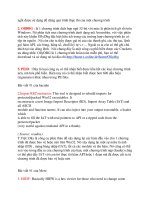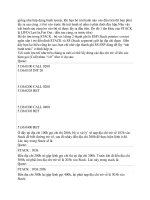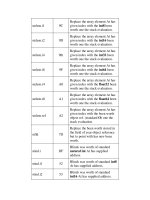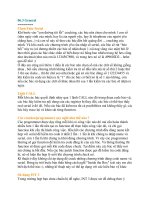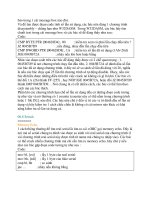Cracker Handbook 1.0 part 38 potx
Bạn đang xem bản rút gọn của tài liệu. Xem và tải ngay bản đầy đủ của tài liệu tại đây (14.78 KB, 6 trang )
computer systems are mentioned, along with the concepts of the assembly
language itself, and continues with the tutorial itself.
1.3 Why learn assembler language
The first reason to work with assembler is that it provides the opportunity
of knowing more the operation of your PC, which allows the development of
software in a more consistent manner.
The second reason is the total control of the PC which you can have with
the use of the assembler.
Another reason is that the assembly programs are quicker, smaller, and have
larger capacities than ones created with other languages.
Lastly, the assembler allows an ideal optimization in programs, be it on
their size or on their execution.
1.4 We need your opinion
Our goal is offers you easier way to learn yourself assembler language. You send
us your comments or suggestions about this 96' edition. Any comment will be
welcome.
2 Basic Concepts
Table of Contents
2.1 Basic description of a computer system.
2.2 Assembler language Basic concepts
2.3 Using debug program
2.1 Basic description of a computer system.
This section has the purpose of giving a brief outline of the main
components of a computer system at a basic level, which will allow the user
a greater understanding of the concepts which will be dealt with throughout
the tutorial.
Table of Contents
2.1.1 Central Processor
2.1.2 Central Memory
2.1.3 Input and Output Units
2.1.4 Auxiliary Memory Units
Computer System.
We call computer system to the complete configuration of a computer,
including the peripheral units and the system programming which make it a
useful and functional machine for a determined task.
2.1.1 Central Processor.
This part is also known as central processing unit or CPU, which in turn is
made by the control unit and the arithmetic and logic unit. Its
functions consist in reading and writing the contents of the memory cells,
to forward data between memory cells and special registers, and decode and
execute the instructions of a program. The processor has a series of memory
cells which are used very often and thus, are part of the CPU. These cells
are known with the name of registers. A processor may have one or two
dozen of these registers. The arithmetic and logic unit of the CPU
realizes the operations related with numeric and symbolic calculations.
Typically these units only have capacity of performing very elemental
operations such as: the addition and subtraction of two whole numbers,
whole number multiplication and division, handling of the registers' bits
and the comparison of the content of two registers. Personal computers can
be classified by what is known as word size, this is, the quantity of bits
which the processor can handle at a time.
2.1.2 Central Memory.
It is a group of cells, now being fabricated with semi-conductors, used for
general processes, such as the execution of programs and the storage of
information for the operations.
Each one of these cells may contain a numeric value and they have the
property of being addressable, this is, that they can distinguish one
from another by means of a unique number or an address for each cell.
The generic name of these memories is Random Access Memory or RAM. The
main disadvantage of this type of memory is that the integrated circuits lose
the information they have stored when the electricity flow is interrupted.
This was the reason for the creation of memories whose information is not
lost when the system is turned off. These memories receive the name of Read
Only Memory or ROM.
2.1.3 Input and Output Units.
In order for a computer to be useful to us it is necessary that the
processor communicates with the exterior through interfaces which allow the
input and output of information from the processor and the memory. Through
the use of these communications it is possible to introduce information to
be processed and to later visualize the processed data.
Some of the most common input units are keyboards and mice. The most
common output units are screens and printers.
2.1.4 Auxiliary Memory Units.
Since the central memory of a computer is costly, and considering today's
applications it is also very limited. Thus, the need to create practical and
economical information storage systems arises. Besides, the central memory
loses its content when the machine is turned off, therefore making it
inconvenient for the permanent storage of data.
These and other inconvenience give place for the creation of peripheral
units of memory which receive the name of auxiliary or secondary memory. Of
these the most common are the tapes and magnetic discs.
The stored information on these magnetic media means receive the name of files.
A file is made of a variable number of registers, generally of a fixed
size; the registers may contain information or programs.
2.2 Assembler language Basic concepts
Table of Contents
2.2.1 Information in the computers
2.2.2 Data representation methods
2.2.1 Information in the computers
2.2.1.1 Information units
2.2.1.2 Numeric systems
2.2.1.3 Converting binary numbers to decimal
2.2.1.4 Converting decimal numbers to binary
2.2.1.5 Hexadecimal system
2.2.1.1 Information Units
In order for the PC to process information, it is necessary that this
information be in special cells called registers. The registers are groups of 8 or 16
flip-flops.
A flip-flop is a device capable of storing two levels of voltage, a low
one, regularly 0.5 volts, and another one, commonly of 5 volts. The low
level of energy in the flip-flop is interpreted as off or 0, and the high
level as on or 1. These states are usually known as bits, which are the
smallest information unit in a computer.
A group of 16 bits is known as word; a word can be divided in groups of 8
bits called bytes, and the groups of 4 bits are called nibbles.
2.2.1.2 Numeric systems
The numeric system we use daily is the decimal system, but this system is
not convenient for machines since the information is handled codified in
the shape of on or off bits; this way of codifying takes us to the necessity
of knowing the positional calculation which will allow us to express a
number in any base where we need it.
It is possible to represent a determined number in any base through the
following formula:
Where n is the position of the digit beginning from right to left and
numbering from zero. D is the digit on which we operate and B is the used
numeric base.
2.2.1.3 converting binary numbers to decimals
When working with assembly language we come on the necessity of converting
numbers from the binary system, which is used by computers, to the decimal
system used by people.
The binary system is based on only two conditions or states, be it on(1) or
off(0), thus its base is two.
For the conversion we can use the positional value formula:
For example, if we have the binary number of 10011, we take each digit from
right to left and multiply it by the base, elevated to the new position
they are:
Binary: 1 1 0 0 1
Decimal: 1*2^0 + 1*2^1 + 0*2^2 + 0*2^3 + 1*2^4
